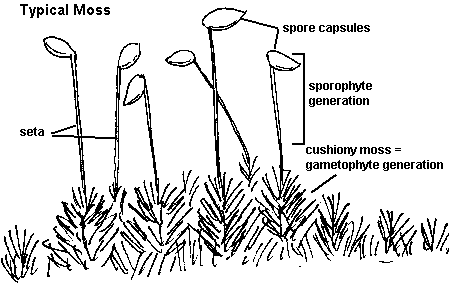Bryophytes lack specialized vascular tissue (xylem and
phloem); without this supporting tissue the plants remain small and low to the ground.
Because they lack vascular tissue, mosses don’t have "true" stems, roots,
or leaves. Nevertheless, these terms are often used to describe the corresponding
structures in mosses.
Most gardeners are familiar with mosses—either
because they cultivate them in their rock gardens, or try to eradicate them from their
lawns. The familiar cushiony green mat represents the gametophyte generation. This is the
dominant and most conspicuous phase. If you get down on your hands and knees for a close
up view, you may see some taller structures emerging from the green mat. The capsules at
the top of these the tall, delicate "stems" (technically termed seta) contain spores. These structures—the
seta and capsules—are the sporophyte generation.

